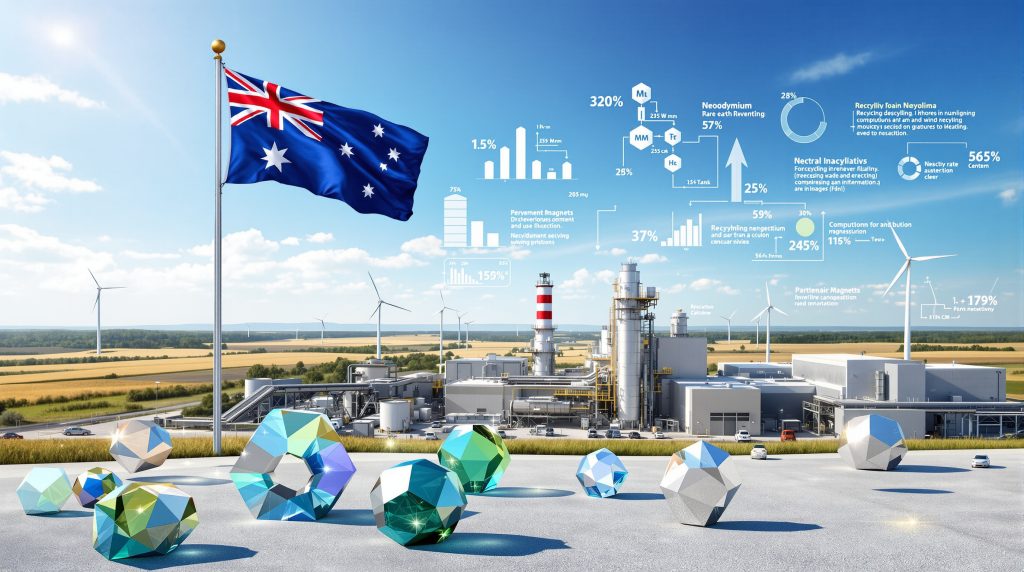Australia-based Ionic Rare Earths has established a transformative partnership with Missouri-based US Strategic Metals, creating a comprehensive framework for advanced permanent magnet recycling operations across American territory. This Ionic Rare Earths US magnet recycling MoU represents a critical development in global rare earth supply chain restructuring, particularly as nations actively pursue alternatives to traditional sourcing approaches. Furthermore, this collaboration directly supports critical minerals energy security initiatives across allied nations.
The memorandum of understanding was formally executed at the Australian Embassy in Washington, D.C., with key executives from both organizations participating in the ceremonial signing. Present at the signing were Michael Holloman, USSM Chief Commercial Officer; Brett Lynch, IonicRE executive chairman; Stacy W. Hastie, USSM founder and CEO; and James Durrant, RareX MD, alongside representatives from Australian and US government agencies.
How Does Ionic's Patented Recycling Technology Work?
The partnership centres on implementing Ionic Technologies' proprietary permanent magnet recycling methodology at US Strategic Metals' comprehensive 728-hectare facility in Missouri. This innovative technology enables efficient extraction and purification of essential rare earth elements from end-of-life magnetic components, converting waste materials into high-value industrial inputs. Moreover, this battery recycling process demonstrates how Australia is positioning itself as a leader in sustainable resource recovery.
Advanced Recovery Capabilities
The recycling process specifically targets five critical rare earth elements essential for high-performance applications:
• Neodymium: Primary component in permanent magnet assemblies for electric vehicle motors
• Praseodymium: Essential for high-strength magnetic applications in renewable energy systems
• Dysprosium: Critical heavy rare earth element for high-temperature magnetic performance
• Terbium: Specialised heavy rare earth used in advanced defense and aerospace applications
• Samarium: Key component for precision magnetic devices and military electronics
Tim Harrison, Managing Director of IonicRE, emphasised the technology's global scalability potential, noting that the company possesses the capability to build this technology worldwide to deliver resilient supplies of high-purity, separated rare earth oxides on a sustainable foundation through proven low-emission processing methods.
The proposed recycling facility will initially concentrate on recovering magnet rare earth oxides, with planned expansion into processing other heavy rare earths and mixed rare earth carbonates as operational capacity increases.
What Makes This Partnership Strategically Important?
Supply Chain Security Implications
This collaboration directly addresses America's strategic objective to eliminate Chinese-sourced rare earths from industrial and defence supply chains by 2027. The ambitious timeline creates significant urgency around developing domestic processing capabilities for these materials critical to national security and economic competitiveness. In addition, this aligns with Australia's broader critical minerals strategy for securing supply chain independence.
The partnership structure offers several distinct advantages over traditional mining operations:
| Recycling Benefits | Traditional Mining Challenges |
|---|---|
| Utilises existing material streams | Requires extensive geological exploration |
| Leverages established collection networks | Involves lengthy mine development processes |
| Demonstrates reduced environmental impact | Necessitates complex environmental permitting |
| Employs simplified processing methods | Involves substantial waste management requirements |
Brett Lynch, IonicRE executive chairman, positioned the partnership as directly supporting the newly established US-Australia Critical Minerals Framework, signed in October by President Donald Trump and Prime Minister Anthony Albanese. Lynch emphasised that the United States represents the largest potential market and expressed enthusiasm for partnering with USSM to deliver rare earth permanent magnet supplies in Missouri, with possibilities for multiple recycling facilities across the United States as part of the company's global expansion strategy.
Environmental and Economic Advantages
The recycling approach delivers substantial environmental benefits compared to primary rare earth production, with documented reductions in carbon dioxide emissions of up to 61% versus traditional mining operations. This environmental performance enhancement aligns with increasing corporate sustainability requirements and government environmental mandates.
Which Industries Will Benefit Most From This Initiative?
The recycled rare earth oxides will primarily serve three rapidly expanding industrial sectors experiencing unprecedented demand growth. Consequently, this represents a significant step forward in the evolution in mining innovation towards more sustainable practices.
Electric Vehicle Manufacturing
The automotive industry's transition to electric propulsion systems creates substantial demand for neodymium-iron-boron magnets in battery management systems and electric motor assemblies. Each electric vehicle requires approximately 1-2 kilograms of rare earth elements, primarily neodymium and dysprosium, for optimal motor performance and efficiency.
Supply chain resilience becomes critical as automotive manufacturers face increasing pressure to secure consistent rare earth supplies while managing cost volatility and geopolitical supply disruptions.
Renewable Energy Infrastructure
Wind turbine generators utilising permanent magnet technology require substantial quantities of rare earth elements, particularly neodymium and dysprosium, for direct-drive generator systems. Each megawatt of wind generation capacity typically requires 200-600 kilograms of rare earth elements, depending on turbine design specifications.
Grid-scale energy storage systems and solar panel tracking mechanisms also incorporate permanent magnet components, creating additional demand streams for recycled materials.
Defence Applications
Military and aerospace applications demand the highest purity rare earth elements for specialised equipment including advanced radar systems, precision-guided munitions, electronic warfare platforms, and satellite communication infrastructure. Defence applications often require heavy rare earth elements like terbium and dysprosium for high-temperature performance characteristics. Furthermore, this initiative directly supports defence critical minerals security objectives.
How Does This Fit Into Global Recycling Trends?
Ionic Rare Earths' Missouri partnership represents a strategic component of a comprehensive international expansion framework. The company has established similar collaborative arrangements across multiple jurisdictions:
United Kingdom: Partnership with European Metal Recycling for European market penetration
South Korea: Strategic alliance with DNA Link targeting Asian regional demand
Australia: Domestic operations serving local and regional requirements
Tim Harrison indicated that the company seeks to replicate capabilities demonstrated in the United Kingdom facility within the United States market, suggesting operational success in European operations serves as a proven model for American expansion.
This multi-jurisdictional deployment creates distributed processing capabilities across allied nations, significantly reducing single-point-of-failure risks in global supply chains whilst establishing resilient rare earth networks outside Chinese influence.
What Are the Economic Implications for Missouri?
Regional Infrastructure Integration
US Strategic Metals operates an established multi-metallic processing and refining platform in Missouri, providing optimal foundation infrastructure for rare earth recycling integration. The facility's existing permits and operational capabilities substantially accelerate project implementation timelines compared to greenfield development approaches.
Stacy W. Hastie, USSM founder and CEO, characterised the partnership as aligning with the company's strategic vision to establish leadership in developing new supply chains for critical minerals and heavy rare earths. According to Hastie, "USSM's processing and refining capabilities in Missouri are specifically designed to meet American demand while collaborating with partners committed to responsible, secure, and sustainable sourcing practices."
Workforce Development Opportunities
The integration of recycling technology into existing infrastructure creates specialised employment opportunities in advanced metallurgical processing, requiring technical expertise in rare earth separation, purification, and quality control methodologies.
Economic Development Factors:
• Job creation in high-skilled metallurgical and chemical processing positions
• Technology transfer fostering local expertise development and knowledge retention
• Potential catalyst for additional recycling facilities across multiple states
• Supply chain ecosystem development supporting regional economic diversification
When Will Operations Begin and Timeline Considerations?
While specific production commencement dates were not disclosed in the memorandum of understanding, the partnership structure indicates rapid deployment capabilities compared to traditional mining development timelines. Ionic's modular technology design enables accelerated implementation schedules, leveraging existing infrastructure rather than requiring extensive construction periods.
Expansion Framework
The agreement incorporates provisions for exploring additional facilities across the United States, demonstrating scalability ambitions extending beyond the initial Missouri location. This distributed approach aligns with national security considerations around critical mineral processing whilst reducing geographic concentration risks.
The modular nature of the technology platform suggests potential replication across multiple sites as market demand and feedstock availability warrant expansion into additional regions.
Strategic Supply Chain Security Benefits
Bilateral Cooperation Enhancement
The partnership directly implements objectives established in the bilateral Critical Minerals Framework between the United States and Australia, emphasising collaborative approaches to supply chain security and technological innovation in critical mineral processing.
Key framework elements include:
• Technology sharing between allied nations for mutual benefit
• Investment facilitation for strategically important projects
• Joint research and development initiatives in critical minerals processing
• Coordinated approaches to supply chain resilience and security
Circular Economy Integration
The recycling methodology transforms end-of-life products into valuable manufacturing inputs, exemplifying circular economy principles whilst creating economic value from previously discarded materials. This approach reduces waste streams whilst establishing sustainable material flows for critical applications.
Market Psychology and Investment Implications
The partnership reflects broader market recognition that recycling represents the most expedient pathway to establishing secure rare earth supply chains outside Chinese control. Traditional mining operations require extensive development periods, environmental permitting, and substantial capital investment before achieving production status.
Risk Mitigation Strategies
Investors and industrial consumers increasingly recognise that diversified supply chains reduce exposure to geopolitical disruptions and price volatility associated with concentrated sourcing regions. The distributed processing model creates multiple supply sources whilst leveraging existing infrastructure investments.
Investment considerations include:
• Faster market entry compared to traditional mining investments
• Lower capital requirements for recycling versus primary production
• Reduced regulatory complexity compared to mining permit processes
• Environmental sustainability credentials supporting ESG investment criteria
Technical and Geological Advantages
Feedstock Availability and Quality
Unlike traditional mining operations dependent on geological ore grades and extraction complexity, magnet recycling utilises concentrated rare earth content from manufactured products. End-of-life magnets contain rare earth concentrations significantly higher than typical ore deposits, enabling more efficient processing and higher recovery rates.
The recycling process avoids geological uncertainties and resource depletion concerns whilst accessing consistent feedstock quality from established collection networks across industrial and consumer applications.
Processing Efficiency Benefits
Magnet recycling bypasses many complexity factors associated with primary production, including ore beneficiation, radioactive waste management, and extensive chemical processing requirements. The simplified processing chain reduces operational complexity whilst maintaining high-purity output specifications.
Long-term Strategic Implications
The Ionic Rare Earths US magnet recycling MoU represents more than a business arrangement; it embodies a fundamental shift toward resilient, sustainable rare earth supply chains supporting national security and economic independence objectives.
Success in this initiative could catalyse similar partnerships across allied nations, creating networks of recycling facilities that collectively reduce dependence on concentrated supply sources. As global demand for rare earth elements continues expanding across electric vehicles, renewable energy, and defence applications, innovative supply chain diversification approaches become increasingly valuable for economic and strategic security considerations.
The partnership demonstrates how technological innovation combined with strategic international cooperation can address critical material security challenges whilst supporting environmental sustainability objectives and economic development goals across allied nations. Indeed, this Ionic Rare Earths US magnet recycling MoU serves as a blueprint for future collaborative efforts in critical minerals recovery and processing.
Disclaimer: This article contains forward-looking statements regarding future operations, market conditions, and strategic developments. Actual results may vary based on market conditions, regulatory changes, and operational factors beyond current projections.
Are You Positioning Yourself to Benefit From Critical Minerals Supply Chain Transformations?
Discovery Alert's proprietary Discovery IQ model delivers instant notifications on significant ASX mineral discoveries, including critical minerals companies benefiting from global supply chain restructuring initiatives like the Ionic-USSM partnership. Explore how major mineral discoveries have historically generated substantial returns and begin your 30-day free trial today to secure your market-leading advantage in this rapidly evolving sector.




